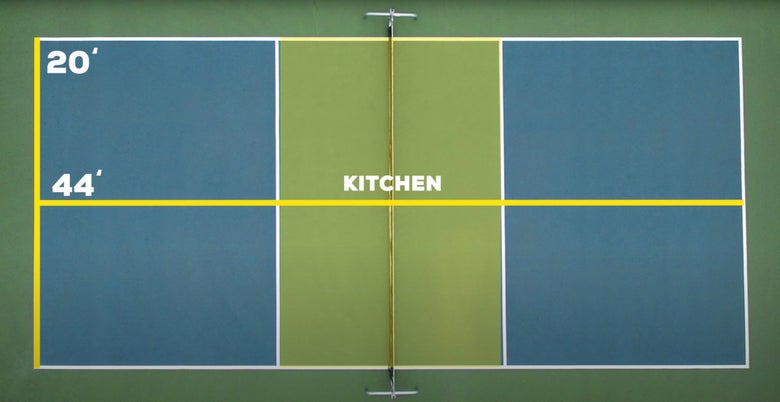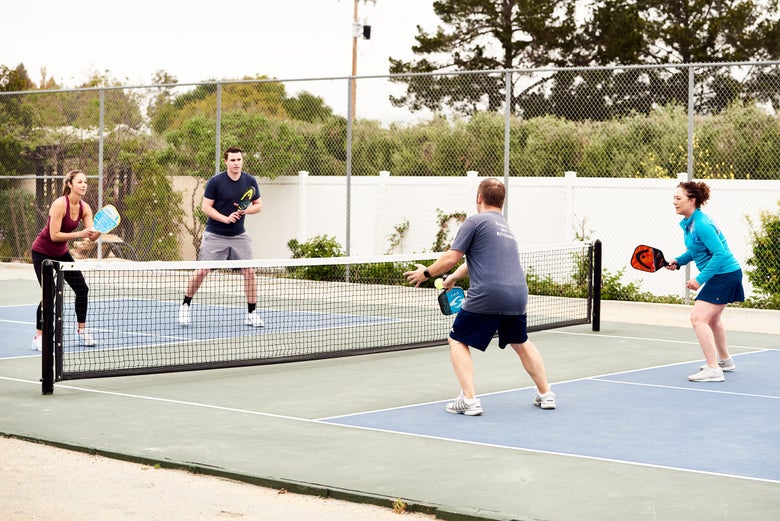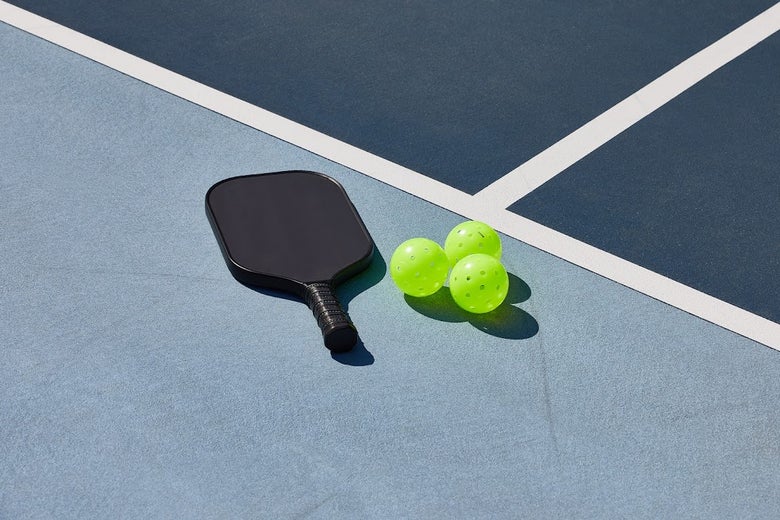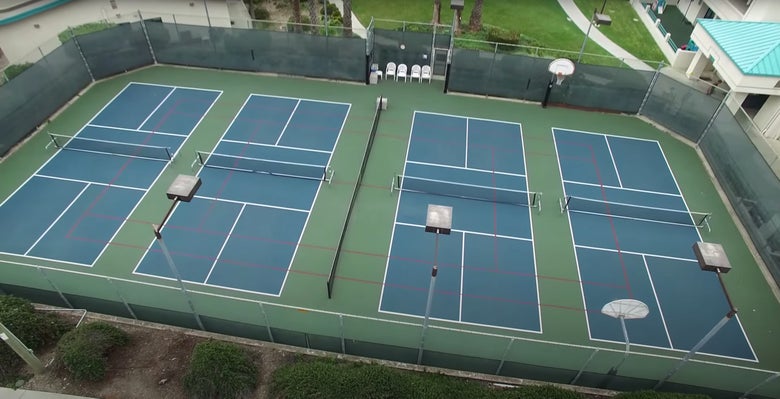How To Play Pickleball
By now, unless you have been living under a pile of rocks, you have probably heard of pickleball. If you want to get started playing and are wondering about the basics like, "How do I Play?" and "What do I Need?" this guide will put you on the right path to help maximize your fun and improvement on a pickleball court!
Pickleball is played on a 44’ x 20’ court, with a 36” net height. In addition a pickleball court is divided up into a right and left side on both ends of the court and also features an area known as either the non-volley zone (NVZ) or the “Kitchen”. The game is played with a paddle, a plastic ball with holes (similar to but not a whiffle ball), and combines some of the best aspects of racquet sports like tennis, badminton and ping pong.
And similar to those three sports, pickleball is a game for both doubles and singles. Doubles pickleball tends to be the most popular in a recreational setting since it offers a fun, fast-paced game that’s social and easy for people of all ages and athletic abilities to pick up. It also happens to be the most popular format on the professional tour as well.
Pickleball Rules
Two-Bounce Rule
Pickleball incorporates what is called the “Two Bounce Rule”. This means you have to let both the serve and the return of serve bounce before hitting shots out of the air.
After the ball is served cross-court to the returning team, the returning team returns the serve off of the bounce (bounce 1). The serving team also has to let the return bounce before hitting it (bounce 2). From there, play is open, meaning everyone is now allowed to take balls out of the air — with the exception of the non-volley zone/kitchen.
*Important sidenotes: The serve must clear the kitchen line in the box diagonal from the server to be valid. Any serve that lands in the kitchen or on the kitchen line is a fault. Currently at the professional tournament level serves that clip the net and land past the kitchen line are re-played, but that rule does not apply to recreational play.
Non-Volley Zone
After the 3rd shot you may hit the ball before or after it bounces anywhere in the court with the exception of one area, the kitchen. Also referred to as the non-volley-zone, the kitchen is the one part of the court where you cannot play the ball before it bounces. This area is 7 feet deep from the net on both sides, and 20 feet wide. If/when shots land in the NVZ you can retrieve them off the bounce, but unless a long protracted dink rally is occurring you need to high-tail it out of the NVZ if you are going to hit the next shot out of the air.
Scoring
At the start of a game, the score is always the same; 0-0-2. Scoring is called out (by the serving team) in a 3-number sequence, which involves first the server’s score, the returner’s score and the last number in the sequence indicates whether player 1 or 2 is serving. For example, if the server calls out a score of 2-1-1, that means their team has two points, the returning team has one point, and are the first of the two servers.
In pickleball points on serve are scored but not when returning, which is referred to as side-out scoring. When starting a new game, the initial serving team only gets one server to balance out the advantage of serving first. Since the person playing on the right side of the court is always the first server of a sequence, they are the only one serving during the first serving sequence (at 0-0-2). When the initial serving team loses the point it’s a side-out, and the opposing team then serves. From there it switches to two servers (each player serves until the loss of a point) for the rest of the game, always beginning with the player on the right side of the court. So, after the first side-out the opposing team starts the score with server one, and when they lose a point it goes to the 2nd server. Once server #2 loses a point it’s a side out, and the serve goes back to the other team. Games are typically played to 11 or 15; win by two.
Score Versus Court Position
Keeping track of the score can be tricky once play commences. Even more challenging is being in the correct court position before each point begins. After a long rally and/or when the serve switches to the side-out, is where it can be a chore to recall which side of the court you need to be on prior to the next point.
Here is an easy way to make certain that (relative to the score) you and your partner are always in the proper court position prior to a point:
- The key is to remember which player started the game on the right service court and who was on the left. From there everything will fall into place.
- The player beginning the game on the right service court always serves or returns from the right side when the score is even (0,2,4,6,8, etc.)
- The player who started the game on the left side always serves or receives from the right side when the score is odd (1,3,5,7,9, etc.)
*Notice that both players start the point from the right side of the court, and the sole determining factor is whether the score is even or odd.
What do I need to start playing pickleball?
Now that you know the basics, let's get you set up for all you need for your first session on court.
Pickleball Paddle
The game is played with a paddle made specifically for the sport of pickleball. Pickleball paddles come in a variety of shapes, weights and material compositions. With so many options out there, it can be confusing to know how to select your first paddle. Our article on How to Choose a Pickleball Paddle will help guide you through the process of finding the paddle that's right for you.
Pickleballs
Pickleballs fall into two categories: Outdoor and indoor. And while indoor and outdoor are the terms used to describe types pickleballs we suggest basing your decision on whether you are playing on a hardcourt/asphalt or a wood laminate surface. Although both ball types look very similar they do exhibit some noticeable differences. Indoor pickleballs tend to be a little softer and lighter than their outdoor counterparts and also have fewer holes (around 26) that are larger. Outdoor pickleballs are typically harder, heavier and have more numerous (around 40) but smaller holes in order to maintain a consistent flight path in outdoor conditions.
Pickleball Shoes
In order to have the best playing experience and to prevent injury, we advocate that pickleball players wear a court specific shoe. Unlike a running or cross-training shoe, court shoes are designed to be more supportive, especially when it comes to complementing lateral movement. As with pickleballs there are also outdoor specific shoes and indoor specific shoes. And again, we suggest focusing more on the surface you are playing on as opposed to whether there is a roof over the court. To learn more about the differences and for further assistance in finding the right pair of shoes for you, check out our article on How To Choose Your Next Pickleball Shoe.
Apparel
Ideally your choice in apparel should not restrict movement and at the same time be able to breathe, insulate and protect you from the sun's rays. Whether you prefer your on-court apparel to made of performance oriented materials, like polyester and lycra, which helps keep you dry while perspiring, or cotton, the choice is yours.
Many players layer their apparel. So when it is cold it it easier to stay warm, and as the on-court action heats up you can then peel off layers. Below you can browse apparel options to see what best suits your style and preferences.
Where can I play pickleball?
Now that you're all geared up, let's figure out where you can locate a court and play your first game.
More and more communities are building pickleball specific courts at local parks and offer open play sessions, lessons and/or league play. For information on indoor play, check with your local community centers as they too may have designated hours for league and open play sessions.
Another option for getting a taste of the sport is to set up your own court using a portable net. These nets are great for use on a tennis court, at the gym, vacant parking lot — wherever you can find some open space with a hard asphalt surface. There are also portable court lines you can use for setting up the parameters of the court. If you can't find enough room for a full-sized court, there are smaller nets that are easy to set up in a driveway or garage space, providing a great avenue for practicing your dink.



